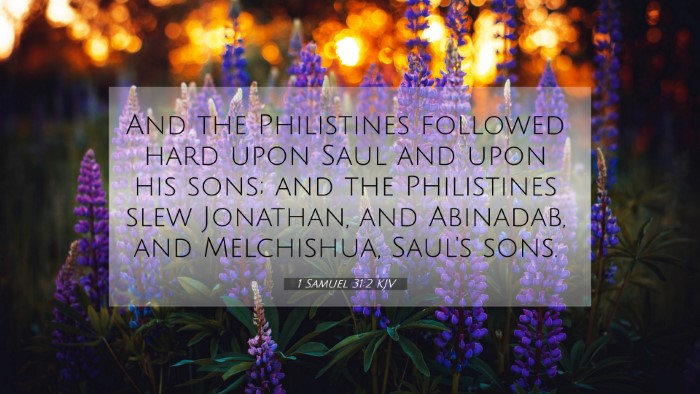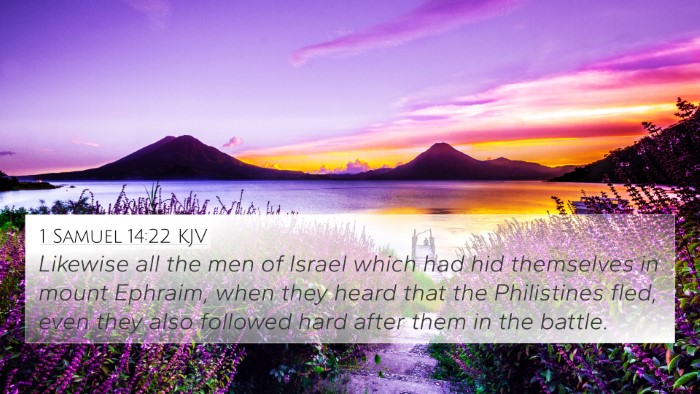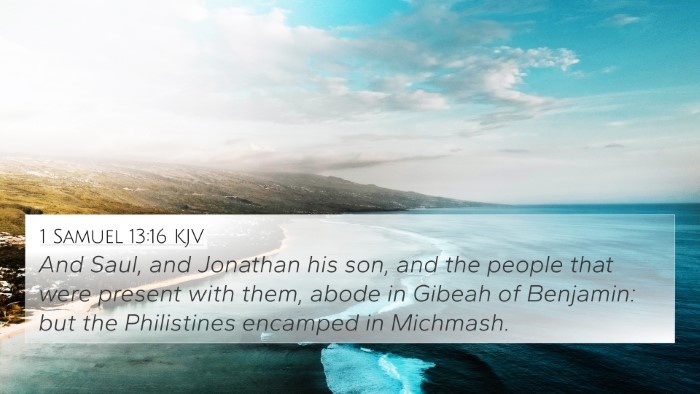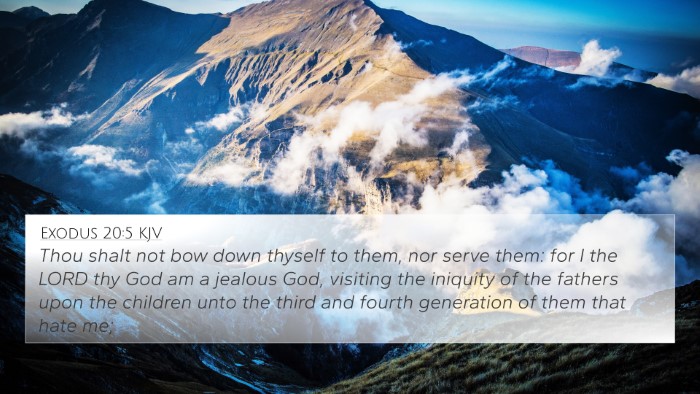Understanding 1 Samuel 31:2
Verse: 1 Samuel 31:2 - "And the Philistines followed hard upon Saul and upon his sons; and the Philistines slew Jonathan, and Abinadab, and Malchishua, Saul's sons."
This verse captures the tragic climax of King Saul's life and reign, detailing the fierce battle between the Israelites and the Philistines. We glean important lessons from the events leading to this moment as well as the implications that resonate throughout Scripture.
Analysis of the Verse
-
Philistine Warfare:
According to commentary insights from Matthew Henry, this verse exemplifies the theme of divine judgment on Saul for his disobedience. The relentless pursuit of Saul's family by the Philistines indicates not just a physical battle but a spiritual one, reinforcing the consequences of turning away from God.
-
The Importance of Jonathan:
Albert Barnes emphasizes the significance of Jonathan's death, highlighting his noble character and loyal friendship with David. This tragic loss symbolizes the end of the hope for the unification of Saul’s kingdom and its subsequent lineage.
-
Saul's Legacy:
Adam Clarke notes that this battle marks the culmination of Saul's tragic story—a life filled with potential yet marred by fear, jealousy, and rejection of God's guidance. His downfall serves as a powerful cautionary tale.
Connections Between Bible Verses
This verse has profound connections with various biblical texts that resonate through the themes of leadership, judgment, and familial ties.
-
1 Chronicles 10:1-14 - Offers a retelling of Saul's end, providing additional context to his choices and their repercussions.
-
2 Samuel 1:17-27 - David’s lament over Jonathan and Saul which highlights the grief and relational aspects arising from their deaths.
-
1 Samuel 28:19 - Focuses on the prophecy of Saul’s impending doom, showcasing the consequences of his disregard for God's law.
-
Hebrews 11:32-34 - References the faith of leaders including the judges of Israel, contrasting them with Saul's failure.
-
Sirach 46:16-17 - In the Apocrypha, it honors the legacy of Jonathan and his bravery, clarifying his role in God’s plan.
-
Romans 15:4 - Discusses the importance of the Scriptures for our instruction, linking the Old Testament narratives to New Testament teachings.
-
Matthew 27:46 - Connects to Saul’s despair, echoing the feelings of abandonment found in his final days.
Thematic Bible Verse Connections
This verse serves as a pivotal moment that echoes themes of leadership failure, the weight of generational sin, and divinely sanctioned judgment. For those exploring the depth of inter-Biblical dialogue, one finds numerous parallels and thematic connections.
Tools for Bible Cross-Referencing
Utilizing a Bible concordance can significantly enhance one's study of such verses. These tools allow for effective cross-referencing, enabling believers to immerse themselves in a deeper understanding of Scripture.
Comparative Bible Verse Analysis
When analyzing 1 Samuel 31:2 alongside other verses, several themes arise concerning obedience to God, the pitfalls of pride, and the human condition.
- Consider linking this with James 4:6, which discusses God opposing the proud—this parallel draws a line between Saul's pride and his ultimate downfall.
- Cross-reference with Proverbs 16:18, reinforcing the notion that pride precedes destruction, mirroring Saul's narrative.
Conclusion
1 Samuel 31:2 is a verse laden with sorrow and significance. It serves as a rich starting point for exploring the complexities of Biblical leadership, family dynamics, and divine justice. Engaging with such verses through cross-referencing and thematic analysis provides a robust framework for understanding the dire consequences of turning away from God.
Recommended Cross-Referencing Methods
To fully appreciate the depth of biblical narratives, consider these cross-referencing Bible study methods:
- Identifying themes: linking narratives that discuss similar moral lessons.
- Charting genealogies: to appreciate the legacy and familial ties, particularly in stories of kings.
- Contextual readings: reading chapters before and after to understand fuller storylines.














